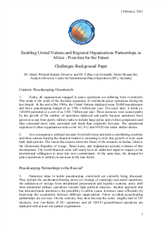BACKGROUND PAPER Enabling United Nations and Regional Organisations Partnerships in Africa – Priorities for the Future

Today, all organisations engaged in peace operations are suffering from overstretch. This strain is the result of the dramatic expansion of worldwide peace operations during the last decade. At the end of the 1990s, the United Nations (UN) deployed some 20,000 peacekeepers and had a peacekeeping budget of ca. US$ 1 billion per year. Ten years later, it fields ca. 120.000 personnel at a cost of ca. US$ 7 billion per year.
These increases were caused partly by the growth of the number of operations deployed and partly because operations have grown in scope from purely military tasks to include large police and civilian components and thus consumed more time, personnel and funds than originally foreseen. The operational capacities of other organisations such as the AU, EU, and NATO are under similar strains. This paper will firstly develop on eight themes:
- Peacekeeping Partnerships to the Rescue?;
- The Advantages of Asymmetry: United Nations and African Union;
- Patterns of Peacekeeping Partnerships in Africa;
- Identifying the Challenges;
- Headquarters Level/Strategic Challenges;
- Field Level/Operational Challenges; and
- Challenges to African Union Capabilities.
Secondly, it will provide recommendations on the Strategic Level, Field Level and on Capacity Building.

